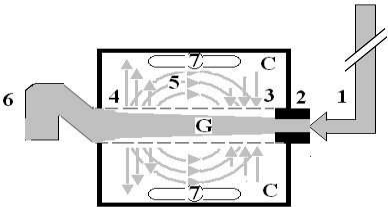Revised Starling’s Principle (RSP): A misnomer as Starling’s law is proved wrong.
Revised Starling’s Principle (RSP): A misnomer as Starling’s law is proved wrong.
Abstract
Substantial evidence based on results of new physics experiments and physiological research affirm Starling’s law wrong. Here we demonstrate that the Revised Starling’s Principle (RSP) is also misleading. The article is a futile attempt to revive Starling’s law after it has long been dead and buried. A most recent article seriously criticized RSP. We hope the excuse for the authors is unawareness of new contributions rather than a desperate attempt to defend the indefensible. Nether Starling nor the authors who made the hypothesis a law were aware of the discovery of the precapillary sphincter that demonstrates capillary pressure induce suction not filtration as demonstrated in the G tube, and the wide intercellular slit pores of the capillary wall that allow the passage of plasma proteins, thus nullifying oncotic pressure in vivo. In addition to previously reported 21 reasons affirming Starling’s law is wrong we add two more that concern the main reports that transformed Starling’s hypothesis into a law. Physiologists and physicists are concerned about formulae and calculations while physicians are more concerned about the lives and safety of their patients. Hence physicians understand the importance of discarding Starling’s law; being wrong is responsible for the induction of the new volume kinetic shocks and the causation of the acute respiratory distress syndrome that kills hundreds of thousands of patients every year. Now, there is a replacement for it: The hydrodynamic phenomenon of the porous orifice (G) tube. It is time to say goodbye Starling’s law, hello G tube.
Downloads
References
Ghanem AN. The Correct Replacement for the Wrong Starling’s law is the Hydrodynamic of the Porous Orifice (G) Tube: The Complete Physics and physiological Evidence with Clinical Relevance and Significance. Research Article. Cardiology: Open Access Cardio Open, 2020 Volume 5 | Issue 1 | 1-9
Ghanem AN. Magnetic field-like fluid circulation of a porous orifice tube and its relevance to the capillary-interstitial fluid circulation: preliminary report. Med Hypotheses. 2001;56(3):325–334. doi:10.1054/mehy.2000.1149
Ghanem KA. and Ghanem AN. The proof and reasons that Starling’s law for the capillary-interstitial fluid transfer is wrong, advancing the hydrodynamics of a porous orifice (G) tube as the real mechanism. Blood, Heart and Circ, 2017; Volume: 1(1): 17 doi:10.15761/BHC.1000102 Available online
Ghanem KA, Ghanem AN. The Physiological Proof that Starling’s Law for the Capillary-Interstitial Fluid Transfer is wrong: Advancing the Porous Orifice (G) Tube Phenomenon as Replacement. Open Acc Res Anatomy. 1(2). OARA.000508. 2017
Woodcock TE, Woodcock TM. Revised Starling equation and the glycocalyx model of transvascular fluid exchange: an improved paradigm for prescribing intravenous fluid therapy. Br J Anaesth. 2012; 108: 384-394.
Michel CC, Woodcock TE, Curry F-RE. Understanding and extending the Starling principle. Acta Anaesthesiol Scand. 2020; 00:1–6. https://doi. org/10.1111/aas.13603
Zdolsek M, Hahn RG, Zdolsek JH. Recruitment of extravascular fluid by hypertonic albumin. Acta Anaesthesiol. Scand. 2018; 62: 1255-1260.
Starling E. H. Factors involved in the causation of dropsy. Lancet 1886; ii: 1266–1270, 1330–1334 and 1406–1410.
Starling EH. On the absorption of fluids from connective tissue spaces. J Physiol. 1896; 19: 312-326
Hahn RG, Dull RO, Zdolsek J. The Extended Starling principle needs clinical validation. Acta Anaesthesiol Scand. 2020; 64: 884–887. https://doi. org/10.1111/aas.13593
Landis EM. Microinjection studies of capillary permeability. II. The relation between capillary pressure and the rate of which fluid passes through the walls of single capillaries. Am J Physiol. 1927;82(2): 217-238.
Pappenheimer JR, Soto-Rivera A. Effective osmotic pressure of the plasma proteins and other quantities associated with the capillary circulation in the hind limbs of cats and dogs. Am J Physiol. 1948; 152: 471- 491.
Rhodin J. A. The ultra-structure of mammalian arterioles and pre-capillary sphincters. J Ultrastructure Research 1967; 18:181–222.
Karnovesky M. J. The ultra-structural basis of capillary permeability studied with peroxidase as a tracer. J Cell Biol 1967; 35: 213–236.
Ghanem AN. Twenty-one reasons affirming Starling’s law on the capillary-interstitial fluid transfer wrong and the correct replacement is the hydrodynamic of the porous orifice (G) tube. Case Rep Open A Open J. 2020; I(1): 8-11
Guyton A. C., Coleman T. G. Regulation of interstitial fluid volume and pressure. Annals New York Academy of Sciences 1968; 150: 537–547
Ghanem AN. The Adult Respiratory Distress Syndrome: Volumetric Overload Shocks in Patho-Aetiology, Correcting Errors and Misconceptions on Fluid Therapy, Vascular, and Capillary Physiology. Surg. Med Open Acc. J. 2(2). SMOAJ.000534.2018. DOI: 10.31031/SMOAJ.2018.02.00053.
Ghanem AN. What are Misleading Physicians into giving too much Fluid During Resuscitation of Shock and Surgery that Induces ARDS and/or AKI?” Asploro Journal of Biomedical and Clinical Case Reports 2020 2020 Apr 8;3(1):90-98
Ghanem AN. Volumetric Overload Shocks (VOS) in Surgical Patients. Open Access J Surg. 2020; 11(2): 555810. DOI: 10.19080/OAJS.2020.11.555810
Ghanem AN. “Volumetric Overload Shocks (VOS) Causing the Acute Respiratory Distress Syndrome (ARDS): The Complete Evidence”. EC Emergency Medicine and Critical Care 4.2 (2020): 01-08.
Ghanem AN. Volume Kinetic Shocks in Clinical Practice. Clin Surg J 3(S3): 1-5. © 2020
The Authors. Published by TRIDHA Scholars
Ghanem, Volumetric Overload Shocks Cause the Acute Respiratory Distress Syndrome: The Plenary Evidence on Patho-Aetiology and Therapy. Op Acc J Bio Sci & Res 1(4)-2020. DOI: 10.46718/JBGSR.2020.01.000024
Ghanem*. Volumetric Overload Shocks Cause Acute Respiratory Distress Syndrome: Building the Bridge Between Physics, Physiology, Biochemistry, and Medicine. Biomed J Sci & Tech Res 29(1)-2020. BJSTR. MS.ID.004758.
Ghanem AN. Editorial. Goodbye Starling's law, hello G tube. J Urol. Nephrol. 2020; 5(1)



























